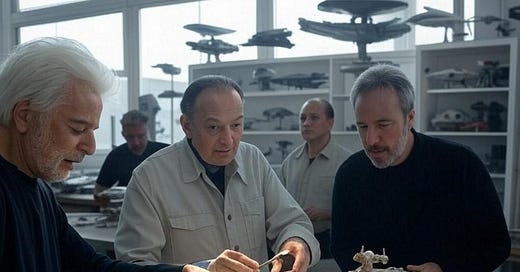In the 1970s, avant-garde filmmaker Alejandro Jodorowsky embarked on one of the most ambitious projects in cinema history: an adaptation of Frank Herbert’s Dune. The project was a dream on a massive scale, with designs by H.R. Giger and Moebius, music from Pink Floyd, and a cast that included Orson Welles, Salvador Dalí, and Mick Jagger. Jodorowsky’s vision was to create nothing less than a cinematic revolution—a film that would expand consciousness and redefine what was possible in storytelling.
But the film never got made.
The production collapsed under the weight of its own ambition, and Jodorowsky’s Dune became a legendary “what if” in the history of science fiction. Yet, the story didn’t end there. What emerged instead was something arguably even more profound: the project brought together a group of extraordinary talents who went on to create groundbreaking work in their respective fields.
The Great People It Brought Together
Out of the ashes of Jodorowsky’s Dune came some of the most influential art and film of the late 20th century. H.R. Giger’s designs became the foundation for Alien. Moebius’s distinctive style went on to influence Tron, The Fifth Element, and countless graphic novels. Dan O’Bannon, who was brought on to work on the script, went on to write Alien, Total Recall, and The Return of the Living Dead.
These creators, united by a shared vision for a project that didn’t materialize, went on to make work that profoundly shaped their industries. The energy and creativity that Jodorowsky cultivated found new outlets—not in Dune itself, but in the collective legacy of its contributors.
The Lesson in Collaboration
The story of Jodorowsky’s Dune is a reminder that the value of a project isn’t always in its completion. Sometimes, the most lasting impact comes from the people it brings together and the ideas it generates. This is especially true for ambitious efforts that aim to break new ground. Even if they fail, they can serve as incubators for future greatness.
It’s easy to judge the success of an effort by whether it achieves its original goal. But what Jodorowsky’s Dune teaches us is that success can also mean planting seeds that grow into something unexpected. The project’s failure wasn’t the end of the story—it was the beginning of many others.
The Parallel in Modern Efforts
In the crypto and tech worlds, we see this dynamic all the time. Not every startup achieves its moonshot, but the relationships, ideas, and tools created along the way often lead to even greater successes. Early teams in failed projects go on to found unicorns. Pioneering technologies that never gained traction inspire new breakthroughs years later. The effort, even if incomplete, sets the stage for what comes next.
Jodorowsky once said his goal wasn’t to adapt Dune but to create “a prophet.” In a way, he succeeded. The project itself became a symbol of what’s possible when bold ideas bring people together. Its legacy isn’t the film that could have been but the many creations that came from its failure.
So the next time you embark on something audacious, remember: even if it doesn’t go as planned, the act of trying can create ripples far beyond what you imagined. Sometimes, the real success is in the people and ideas you gather along the way.



